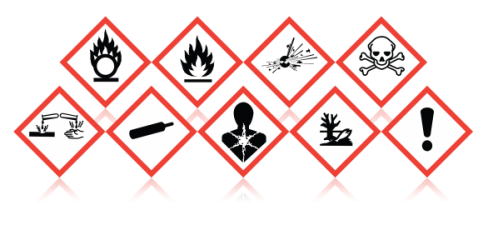Update: July 16, 2021
I like to say that GHS (the Globally Harmonized System) is certainly global, but far from ‘harmonized’. Some ‘flavor’ of GHS has been adopted or is being evaluated in over 70 countries. GHS continues to evolve, the UN publishes a new version every 2 years. Version 8 of GHS was adopted in July of 2019.
When countries (or legislative regions) adopt GHS, they need to decide which version to adopt and which ‘building blocks’ (the term for the GHS categories and sub-categories) to adopt. The outcome of this is countries with similar, but not identical regulations.
The downloadable spreadsheet details the GHS building blocks which each country (or legislative region) has adopted. Below are some highlights of the country-specific variations that may impact your business.
Canada
Canada has adopted several non-standard GHS classifications Biohazard, Combustible Dust, Simple Asphyxiant and Pyrophoric Gas. The Biohazard classification has a pictogram.
If the actual ingredient percentage is not displayed, a specific percent banding must be used.
In the standard GHS wording, you MAY omit H318, if H314 applies to the product. Canadian regulation makes this mandatory. If there is a requirement to provide the hazard statement “Causes severe skin burns and eye damage”, any requirement to provide the hazard statement “Causes serious eye damage” does not apply.
Canada also has adopted the lower 0.1% cutoff for sensitizers, carcinogen and reproductive toxin category 2. A 1% cut-of for Single Target Organ (single and repeated) category 2 has been adopted.
European Union (CLP regulation)
EU has adopted the lower 0.1% cutoff for acute toxicity categories 1-3, aquatic acute category 1 and aquatic chronic category 1.
Hong Kong
Hong Kong has not adopted GHS, but GHS SDS and labels in English and Traditional Chinese are acceptable.
Japan
Japan adopted GHS version 4, but version 6 will be adopted in May of 2022.
Japan also has adopted the lower 0.1% cutoff for sensitizers, carcinogen and reproductive toxin category 2. A 1% cut-of for Single Target Organ (single and repeated) category 2 has been adopted.
Malaysia
Malaysia requires that SDS must be in the local language and English.
Temperatures must be provided in both Fahrenheit and Celsius.
Republic of Korea
Confidential Business Information (CBI) may not be claimed unless the ingredient has been registered with the government.
All SDS must be registered with the MoEL before production or distribution. This may only be done by a Korean company, or an “Only Representative” or “OR”. The “OR” must be a Korean company or citizen.
United States
US has adopted several non-standard GHS classifications Combustible Dust, Simple Asphyxiant and Pyrophoric Gas.
US also has adopted the lower 0.1% cutoff for sensitizers, carcinogen and reproductive toxin category 2. A 1% cut-of for Single Target Organ (single and repeated) category 2 has been adopted.
All information on this article and the attached spreadsheet is for guidance purposes only. This data is not a complete detailing of the regulations, but only intended to point out differences in the regulations. Please make sure to check the relevant legislation.







